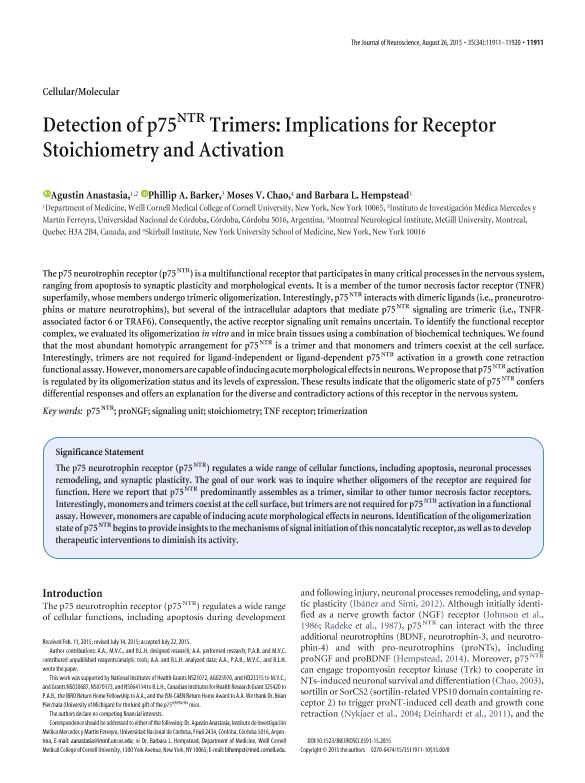Mostrar el registro sencillo del ítem
dc.contributor.author
Anastasia Gonzalez, Agustin

dc.contributor.author
Barker, Phillip A.
dc.contributor.author
Chao, Moses V.
dc.contributor.author
Hempstead, Barbara L.
dc.date.available
2023-01-27T13:02:17Z
dc.date.issued
2015-08-26
dc.identifier.citation
Anastasia Gonzalez, Agustin; Barker, Phillip A.; Chao, Moses V.; Hempstead, Barbara L.; Detection of p75NTR trimers: Implications for receptor stoichiometry and activation; Society for Neuroscience; Journal of Neuroscience; 35; 34; 26-8-2015; 11911-11920
dc.identifier.issn
0270-6474
dc.identifier.uri
http://hdl.handle.net/11336/185891
dc.description.abstract
The p75 neurotrophin receptor (p75NTR) is a multifunctional receptor that participates in many critical processes in the nervous system, ranging from apoptosis to synaptic plasticity and morphological events. It is a member of the tumor necrosis factor receptor (TNFR) superfamily, whose members undergo trimeric oligomerization. Interestingly, p75NTR interacts with dimeric ligands (i.e., proneurotro-phins or mature neurotrophins), but several of the intracellular adaptors that mediate p75NTR signaling are trimeric (i.e., TNFR-associated factor 6 or TRAF6). Consequently, the active receptor signaling unit remains uncertain. To identify the functional receptor complex, we evaluated its oligomerization in vitro and in mice brain tissues using a combination of biochemical techniques. We found that the most abundant homotypic arrangement for p75NTR is a trimer and that monomers and trimers coexist at the cell surface. Interestingly, trimers are not required for ligand-independent or ligand-dependent p75NTR activation in a growth cone retraction functional assay. However, monomers are capable of inducing acute morphological effects in neurons. We propose that p75NTR activation is regulated by its oligomerization status and its levels of expression. These results indicate that the oligomeric state of p75NTR confers differential responses and offers an explanation for the diverse and contradictory actions of this receptor in the nervous system.
dc.format
application/pdf
dc.language.iso
eng
dc.publisher
Society for Neuroscience

dc.rights
info:eu-repo/semantics/openAccess
dc.rights.uri
https://creativecommons.org/licenses/by-nc-sa/2.5/ar/
dc.subject
P75NTR
dc.subject
PRONGF
dc.subject
SIGNALING UNIT
dc.subject
STOICHIOMETRY
dc.subject
TNF RECEPTOR
dc.subject
TRIMERIZATION
dc.subject.classification
Neurociencias

dc.subject.classification
Medicina Básica

dc.subject.classification
CIENCIAS MÉDICAS Y DE LA SALUD

dc.title
Detection of p75NTR trimers: Implications for receptor stoichiometry and activation
dc.type
info:eu-repo/semantics/article
dc.type
info:ar-repo/semantics/artículo
dc.type
info:eu-repo/semantics/publishedVersion
dc.date.updated
2023-01-23T16:41:31Z
dc.identifier.eissn
1529-2401
dc.journal.volume
35
dc.journal.number
34
dc.journal.pagination
11911-11920
dc.journal.pais
Estados Unidos

dc.journal.ciudad
Washington D.C
dc.description.fil
Fil: Anastasia Gonzalez, Agustin. Consejo Nacional de Investigaciones Científicas y Técnicas. Centro Científico Tecnológico Conicet - Córdoba. Instituto de Investigación Médica Mercedes y Martín Ferreyra. Universidad Nacional de Córdoba. Instituto de Investigación Médica Mercedes y Martín Ferreyra; Argentina. Cornell University; Estados Unidos
dc.description.fil
Fil: Barker, Phillip A.. McGill University; Canadá
dc.description.fil
Fil: Chao, Moses V.. University Of New York. School Of Medicine; Estados Unidos
dc.description.fil
Fil: Hempstead, Barbara L.. Cornell University; Estados Unidos
dc.journal.title
Journal of Neuroscience

dc.relation.alternativeid
info:eu-repo/semantics/altIdentifier/url/https://www.jneurosci.org/content/35/34/11911
dc.relation.alternativeid
info:eu-repo/semantics/altIdentifier/doi/http://dx.doi.org/10.1523/JNEUROSCI.0591-15.2015
Archivos asociados
